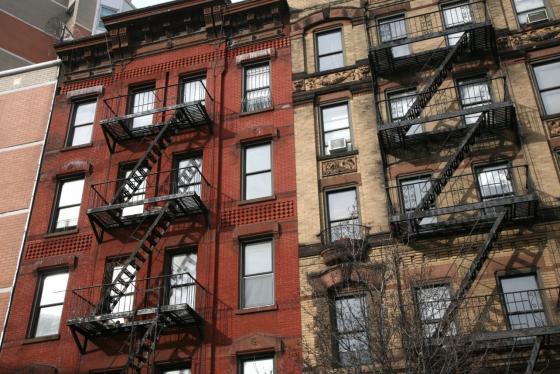Green Building Community
Health, Income, and Energy Efficiency Access: It’s all Connected
Posted by: gracemorrison

Energy efficiency, a term used to compare the amount of energy required for a product to work, is becoming increasingly important in our fight against climate change. Since energy-efficient products use less energy, they call for less electricity which helps lower emissions if the energy source is fossil fuels. There is another appealing factor to these energy-efficient products: energy efficiency means lower electricity bills. Energy-efficient utilities call for lower energy consumption, meaning you pay less for using products better for the environment, so this option seems to be an obvious choice, right? Well, yes and no. The long-term benefits of energy efficiency mean a lower financial burden from electricity; however, the initial costs can be high, especially for retrofitting an existing building. While eventually, energy-efficient products will consistently save a consumer money, putting forth the money for the upfront payment is not an option for everyone.
Homes without these products are disproportionately those of low-to-moderate income (LMI), leading to a higher energy burden. This burden means that those in low-income households are spending three times as much of their income, compared to the median spending of non-low-income households, on energy costs. Moreover, the high energy burden threshold is 6%, but in five metro areas (Baltimore, Philadelphia, Detroit, Boston, and Birmingham), at least 25% of low-income households have energy burdens above 18%, three times that threshold. These burdens fall disproportionately on people of color as they are more likely to live in these LMI households. For example, a study shows that black communities are 68% more likely to live within 30 miles of a coal power plant and average 15% lower property values as a result. Without green energy, housing only reaffirms the poverty cycle, disproportionately creating obstacles for people without the proper resources to invest in their futures.
Furthermore, not only does energy efficiency in green buildings affect costs, but also on health. Housing without these energy-efficient products leads to symptoms of sick building syndrome or even more explicitly, carbon monoxide poisoning, lead exposure, and respiratory problems; additionally, these unhealthy environments can also worsen pre-existing conditions. We cannot address these health effects without citing asthma as an example. While asthma can be genetic, environmental triggers without proper ventilation and exposure to pollution only worsen it. Additionally, fossil fuels in cooking contribute to asthma, an example of which is that homes with gas stoves increase children’s risk of asthma by 24-42%. This factor specifically affects the black population, as black adult Americans are 40% more likely to have asthma than white Americans and are almost three times more likely to die from asthma. These effects are even worse for black children, as they have a death rate from asthma eight times that of white children and are five times more likely to be admitted to the hospital for asthma.
The lack of energy-efficient affordable housing not only contributes to the poverty cycle with higher energy bills but also to the health of those living in LMI households. This is where we should look to loans and grants to provide those living in LMI households with the proper funding to increase their energy efficiency, helping their financial situation and overall health. To create this progress, we must prompt our legislators to produce benefits properly targeted toward LMI households and people of color. To achieve equity, our legislators must help those subjugated to discrimination in housing by providing financial incentives to transition off fossil fuels and gain the equipment to receive lower energy bills and lower healthcare costs.
We can achieve this goal by looking to institutions that have begun to model this practice. Massachusetts, with the new Mass Save Program rewrite, will cover 100% of the cost of energy-efficient home measures for those low-income households. Additionally, the state may cover 100% of the costs for air sealing and insulation measures for renters. Also, moderate-income households may qualify for the state's Income Eligible Program, including free upgrades and other savings, and even higher-income residents qualify for specific savings. Another example of this is the Zero-Emissions Homes Act, helping provide up to $10,000 in rebates, or $14,000 for LMI households, for space heaters, water heaters, and electric systems. These measures help alleviate the disproportionate burden on discriminated communities, but also help the entire public transition from fossil fuels toward a healthier, more energy-efficient future.
Yet another model we should look to is certain California institutions in their move toward decarbonization. San Joaquin Valley Pilot Programs plan to retrofit homes with green, electric appliances in underprivileged communities at no cost, reducing the household’s energy costs with the ultimate goal of using these homes to encourage energy efficiency on a large scale in San Joaquin Valley. Another program in California, the Energy Saving Assistance Program, offers the cost-free opportunity to improve the energy efficiency of homes for low-income households. Additionally, the Affordable Housing and Sustainable Communities Program offers grants for affordable housing to become fully electric, choosing projects on a point system. These programs facilitate access to energy efficiency, meaning lower costs and healthier communities. In our battle with climate change, we cannot overlook the needs of disadvantaged households and look to provide the tools for sustainability to all.
Sources
- [cover image] Vincent Desjardins
- Carver, Effekhari, Jaffee, Mayrides, Brown, Riemenschneider, Zizza, (2020). “Asthma Disparities in America,” AAFA, n.d. https://www.aafa.org/asthma-disparities-burden-on-minorities.aspx
- CDC Team, (2022).“Chronic Disease Indicators: Explore by Location,” DPH, CDC, n.d. https://nccd.cdc.gov/cdi/rdPage.aspx?rdReport=DPH_CDI.ExploreByLocation.
- Colton, Laurent, MacNaughton, Kane, Bennett-Fripp, Spengler, and Adamkiewicz, (2015).“Green Public Housing May Reduce Environmental Health Risks,” Harvard T.H. Chan School of Public Health, n.d. https://www.hsph.harvard.edu/news/press-releases/green-public-housing-may-reduce-environmental-health-risks/.
- Drehobl, Ross, Ayala, (2020), “How High Are Household Energy Burdens?”, ACEEE, nd. https://www.aceee.org/sites/default/files/pdfs/u2006.pdf
- Ettenson, Lara, (2020).“Energy Efficiency Reform Is Needed to Reach All Communities,” NRDC, n.d. https://www.nrdc.org/experts/lara-ettenson/energy-efficiency-reform-needed-reach-all-communities.
- Kresowik, Peterson, (2021). “How Congress Can Accelerate Zero-Emissions Homes,” RMI, n.d. https://rmi.org/how-congress-can-accelerate-zero-emissions-homes/
- Noor, Dharna, (2022). “What the New Mass Save Rewrite Means for You,” The Boston Globe, n.d. https://www.bostonglobe.com/2022/02/02/science/what-new-mass-save-rewrite-means-you/.
- OMH Team, (2021). “Asthma and African Americans,” The Office of Minority Health, n.d. https://minorityhealth.hhs.gov/omh/browse.aspx?lvl=4&lvlid=15
- Rewiring America Team, (2021), “High-Efficiency Electric Home Rebates Act (HEEHRA), Formerly Known as ZEHA,” Rewiring America, n.d. https://www.rewiringamerica.org/policy/zero-emission-homes-act.
- Tieskens, K.F., Milando, C.W., Underhill, L.J. et al., (2021).“The Impact of Energy Retrofits on Pediatric Asthma Exacerbation in a Boston Multi-Family Housing Complex: A Systems Science Approach” Environmental Health, n.d. https://ehjournal.biomedcentral.com/articles/10.1186/s12940-021-00699-x.
- Velez, K., Borgeson, M., (2022) CA Building Decarbonization: What’s Coming in 2022? | NRDC [WWW Document]. URL https://www.nrdc.org/experts/kiki-velez/ca-building-decarbonization-whats-coming-2022
Please be kind and respectful!
Please make sure to be respectful of the organizations and companies, and other Rate It Green members that make up our community. We welcome praise and advice and even criticism but all posted content and ratings should be constructive in nature. For guidance on what constitutes suitable content on the Rate It Green site, please refer to the User Agreement and Site Rules.
The opinions, comments, ratings and all content posted by member on the Rate It Green website are the comments and opinions of the individual members who posts them only and do not necessarily reflect the views or policies or policies of Rate It Green. Rate It Green Team Members will monitor posted content for unsuitable content, but we also ask for the participation of community members in helping to keep the site a comfortable and open public forum of ideas. Please email all questions and concerns to admin@rateitgreen.com

